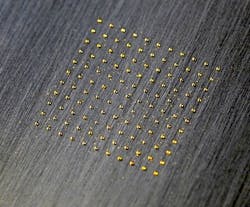Aachen, Germany--Scientists at the Fraunhofer Institute for Laser Technology ILT have come up with a laser-based approach for fabricating clad-gold contacts for electrical switches, replacing conventional electroplating and potentially reducing the amount of gold used by 90%.
Plated-metal switches are the preferred choice for any application that requires durable keys (keyboards, mobile-phone buttons, and so on); manufacturers are seeking cheaper production methods for these switches and new ways of making more efficient use of expensive, high-quality materials such as gold, used for electrical contacts.
Within the scope of the Mifulas 2 project funded by Germany’s Federal Ministry of Education and Research (BMBF), researchers at Fraunhofer ILT, working in collaboration with their project partner Inovan (Stolberg, Germany), have been drawing on their experience in laser cladding to replace the electroplated gold layers on switch contacts known as "snap domes" with small welded gold spots. Snap domes have small contact springs that are used to make electrical contact and provide tactile feedback in a wide range of keyboard designs. They generally consist of high-quality spring steel that is typically gold-plated or modified in some other way to achieve better contact and more-reliable switching. As well as having low contact resistance, gold also has outstanding resistance to corrosion.
The new method replaces the conventional large gold surfaces with small contact spots that are cladded by a fiber laser. Using gold powder with grain diameters smaller than 10 µm, the fiber laser takes advantage of its beam diameter of less than 100 µm to create contact spots with a diameter and height of less than 100 µm.
The laser cladding technique uses a nozzle to feed the gold powder into the interaction zone of the laser beam and the substrate material (which could be, for example, stainless steel or nickel alloy). The laser energy melts both the gold powder and a thin surface layer of the substrate to create a welded spot that is metallurgically bonded to the substrate. Cladding a single point takes approximately 50 ms. Researchers are currently investigating how to accelerate the process; experts consider that it should be possible to weld 20 contact spots simultaneously in the future by splitting the laser beam.
Less gold
One of the biggest advantages of this new method is its material efficiency. Replacing the thin gold layer conventionally deposited on snap domes requires just five selectively welded gold contact spots; initial calculations suggest that this slashes the amount of material required to make the gold contact by between 50% and 90%.
Preliminary tests carried out by Inovan consisting of 100,000 switching operations show that this new approach does not measurably affect switch service life. In addition, the electrical properties of the gold contact spots are as good as those obtained from electroplating.
About the Author
John Wallace
Senior Technical Editor (1998-2022)
John Wallace was with Laser Focus World for nearly 25 years, retiring in late June 2022. He obtained a bachelor's degree in mechanical engineering and physics at Rutgers University and a master's in optical engineering at the University of Rochester. Before becoming an editor, John worked as an engineer at RCA, Exxon, Eastman Kodak, and GCA Corporation.

